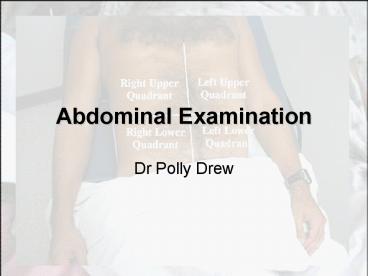Abdominal Examination PowerPoint PPT Presentation
1 / 30
Title: Abdominal Examination
1
Abdominal Examination
- Dr Polly Drew
2
Objectives
- To succinctly examine the abdomen and present
your findings to a consultant examiner in 6
minutes - Discuss disease processes behind your clinical
findings - Pass the exam.
3
Likely osce patients
- Organomegaly hepatomegaly, splenomegaly,
polycystic kidneys - Abdominal masslymphoma, pseudocyst, renal
transplant - Jaundice
- Hernia
- Ascites
- Aneurysm AAA
- Stoma
4
Introduction
- Introduce yourself
- Ask permission to examine
- Ask if any pain anywhere
- Are they comfortable lying flat?
5
Stand at the end of the bed STOP Look for a few
seconds Show you are looking around the
bed Oxygen Catheters Drains Fluids Dressings
Position Comfortable?
Generally ?cachetic Pallor
Jaundiced Bruising Tatoos
6
HANDS/ARMS
- Look at both hands for
- Clubbing
- Leuconychia/koilonychia
- Dupuytrens contracture
- Pallor of skin creases
- Stretch out arms for liver flap
- Palpate radial pulse
7
(No Transcript)
8
(No Transcript)
9
HEAD
- Look at the eyes
- Jaundiced Sclera
- Conjunctival pallor
- Keiser fleischer rings
- Look at the mouth
- Dentician
- Hydration
- Nutrition tongue
- Breath (ketosis/halitosis)
- Thrush?
10
NECK/CHEST
- Palpate cervical lymph nodes
- Left supraclavicular fossa for Virchows
node/Troisiers sign (esp. if mass in abdo) - CHEST
- Spider Naevi
- Pupura
- Gynaecomastia
- Scratch marks (icteric)
11
(No Transcript)
12
(No Transcript)
13
(No Transcript)
14
ABDOMEN
- LOOK
- Scars ?pathology
- Stoma ?type.examine it!
- Veins ?portal hypertension
- Distension
- Masses
- Peristalsis
- COUGH!!
- Define edges of defect
15
(No Transcript)
16
(No Transcript)
17
(No Transcript)
18
(No Transcript)
19
ABDOMEN
- FEEL
- Kneel down
- Ask re tenderness
- Palpate LLQ ? RLQ
- Tenderness
- Guarding
- Rigidity
- Mass.what are you look for?
20
ABDOMEN
- MASS
- Size
- Site
- Shape
- Surface ?Fixed
- Edge
- Consistency
- Percussion note
- Bruit/bowel sounds
21
ABDOMEN
- PALPATE ORGANS
- Liver
- RIF ? RUQ
- Define upper and lower borders by percussion
- Surface texture?
- Spleen
- RIF ? LUQ ?ask patient to roll towards you
- Percuss ?extent surface texture
- Kidneys
- Ballot
- R side then L side
- ?CAPD ?Dialysis ?Transplant
- Aortic Aneurysm
- ?expansile pulsation ?size ?examine fem/pop
pulses
22
(No Transcript)
23
ABDOMEN
- ASCITES
- Shifting Dullness
- Percuss centrally then to each flank
- Locate point of change on R side
- Ask patient to roll towards you
- Wait.
- Percuss again ?area of dullness moved
- Fluid Thrill
- ?use patients hand in midline
- Flick one side and feel the other side
24
(No Transcript)
25
(No Transcript)
26
ABDOMEN
- LISTEN
- Bowel sounds
- 2 areas
- Up to 30 seconds
- ?pitch
- ?quiet
- Aorta for Bruit
- Renal bruits
- If hepatomegaly present auscultate over liver
27
THEN
- Cover the patient up
- Turn to the examiner
- I would like to complete my examination by
examining the external genitalia, performing a
digital rectal examination and dipstick the
urine. - Present your findings!!!
28
FINDINGS
- The hardest part!
- Stand up straight
- Take your stethoscope and hold it in your hands
behind your back - Look the examiner in the eye
- No ers
- No thought I heards
29
Normal Examination findings
I examined this elderly gentlemans abdomen. On
general inspection from the end of the bed he
appeared comfortable at rest. There were no
peripheral signs of abdominal or liver disease.
His abdomen was soft and non-tender with no
distension. There were no palpable masses or
organomegaly. Bowel sounds were present. In
summary, this is an elderly gentleman with normal
abdominal examination.
30
Abnormal Findings
- Present in the same order as for normal
- Describe succinctly
- 5 cm firm mass in epigastrum, non-mobile, not
pulsatile - 4cm liver edge
- Include important negatives onlythis will come
with knowledge

